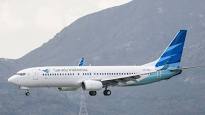Boeing promoted 737 MAX as requiring little additional pilot training
New evidence has surfaced that Boeing told its commercial airline customers that the 737 MAX was fundamentally similar to previous versions of the workhorse jet, despite the addition of a stability system investigators are scrutinizing in probes of the Lion Air and Ethiopian crashes.
The planes are so similar, the sales pitch went, that airlines could avoid extensive and costly training for pilots who flew earlier versions of the 737.
At the Paris Air Show in 2017, Boeing's 737 MAX chief pilot at the time, Ed Wilson, highlighted the similarities between the 737 MAX 9 and the previous series known as the Next Generation or NG. At the time, the video of the demonstration was posted by the aviation website FlightGlobal.
"The airplane is configured to be very common with the NG," Wilson, who is now retired, said, "and so a pilot can walk into here and will find everything he can just like he can in the NG."
"FAA-approved this for two-and-a-half hours of computer-based training for the transition between the two aircraft," Wilson continued. "All the overhead panel switches are the same. The only minor difference is, because of the change in the display, is to move some of the center console items here on the forward console."
What Wilson did not mention in the video is a new computerized control system, the Maneuvering Characteristics Augmentation System or MCAS, which appears to be at the center of investigations into two recent crashes involving the 737 MAX 8.
After a 737 MAX flown by Lion Air crashed in late October, pilots' unions said MCAS was not disclosed in the plane's manual. CNN has not independently viewed the flight manual.
The FAA said Friday that prior to the Lion Air incident, pilots had the knowledge to handle the plane pitching sharply downward, even if they did not know the MCAS system was the cause.
"While Boeing 737 MAX training requirements do not address the MCAS by name, the requirements do include the knowledge to deal with an MCAS event," the agency said.
Following the Lion Air crash, the manual was "revised to reinforce to flight crews how to recognize and respond to uncommanded stabilizer trim movement and MCAS events," the FAA said.
After the Lion Air crash, Boeing sent out a statement that said the manual "already outlines an existing procedure to safely handle the unlikely event of erroneous data coming from an angle of attack (AOA) sensor," which feeds into the MCAS system, but did not specifically address whether the MCAS system was part of the manual.
The MCAS system operated when auto pilot functions were turned off, and pilots believed they had control over the plane, according to pilots who spoke to CNN.
A preliminary investigative report into the Lion Air crash revealed the pilots were struggling to stabilize the plane, which was repeatedly pitching downward, as the MCAS system received faulty data. After a 737 MAX crashed in Ethiopia earlier this month, the Federal Aviation Administration said data shows "some similarities between the two accidents" and grounded the plane for further information and a fix.
In its promotional materials for the MAX, Boeing highlighted the similarities between the two series and called the transition an "easy proposition."
"The airplane's commonalities with previous 737 models will allow for easy integration into existing 737 fleets," the company wrote in its quarterly magazine in 2014, Aero. A similarly laid out cockpit display "preserves commonality with training across the 737 family," it said.
Boeing's website said, "Millions of dollars will be saved because of its commonality with the Next-Generation 737," including maintenance and "wide availability of 737 pilots."
"737 Flight Crews Will Feel at Home in the MAX," the website read.
The Allied Pilots Association said after the FAA's decision to ground the MAX fleet that it concurs with the decision but "remains confident in the Boeing 737 Max and in our members' ability to safely fly it."
The union had previously said it first learned of the MCAS system when Boeing issued a safety directive following the Lion Air crash.
Pilots at American Airlines, who are represented by APA, and Southwest Airlines, who are represented by a different union, moved from older versions of the 737 to the MAX by taking an online course that lasted between 56 minutes and three hours, according to union spokesmen.
That training included some differences between the two-plane series but did not explain MCAS, they said.
"MCAS was installed in the aircraft and Boeing didn't disclose that to the pilots," Mike Trevino, a spokesman for the Southwest Airlines Pilots Association, told CNN.
News Courtesy: www.cnn.com











